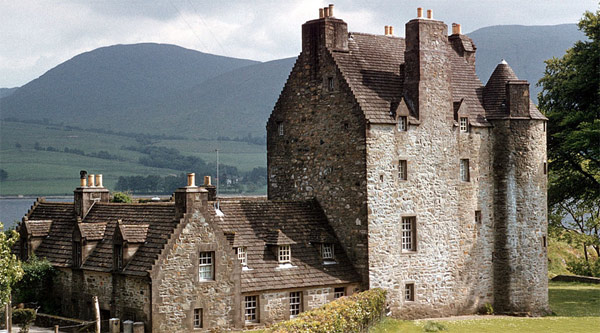
Many mysteries and conflicting stories surround Dunderave Castle, a castle which stands in grand solitude on a rocky point jutting out into the silver waters of Loch Fyne. The setting only magnifies the mystery and magic of the place.
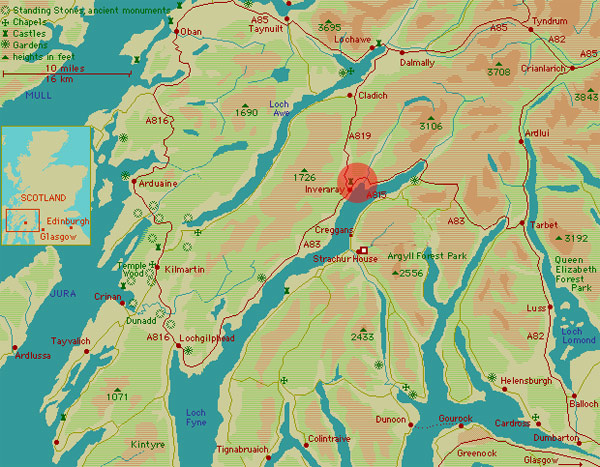
By 1710 she fell into the clutches of the Argyll Campbells and her splendour declined until she was roofless and left to the wind and ice. Yet with the restoration of 1911-12 Dunderave’s shadows came creeping back.
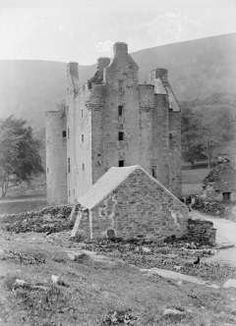
Dunderave Castle is situated at the southern base of densely wooded hills that rise to the frosty heights of 3,110 foot Beinn Bhuidhe. The castle is less than fiive miles northeast of Inveraray, on the northern bank of Loch Fyne. Prior to 1740 the main access to Dunderave was via Loch Fyne onto the castle’s slipway, from there a path led to the castle’s entry, a square tower at the inside angle of the L-plan structure.
Built at the external angle of the L is a five-story round tower which offered a wide field of vision and a vantage point for defensive fire. Although the L-plan is typical of the Scottish tower-house Dunderave was not the mere fortified stronghold of a course and intimidated chieftain.
Despite the expansionist policies of the Cambells of Argyll and despite having Campbells nestled like pet cobras on every border, Iain MacNaughtan began his castle in 1593 as a symbol of strength, pride and prestige.
MacNaughtan had reason to stand strong. He was from an ancient line that descended from Pictish kings. A resplendent, passionate and cavalier Scottish laird, Iain claimed kinship with the 10th-century Nechtan Mor who was of the family of the Thanes of Loch Tay.
Prior to the construction of Dunderave, the chief’s seat was Dubh Loch Castle, standing on a hillock below the loch of that name and in view of Inveraray. In the middle of the 16th century, linen merchants brought Black Plague to the Dubh Loch, nearly wiping out the house of MacNaughtan. The dead were buried nearby, the spot thence forward known as Bruach-nam-Uaighean, “the bank of the graves.” For fear of the plague spreading, Dubh Loch Castle was put to the touch. All that remains at the site today are ancient ghosts and a grassy knoll crowned by a hawthorn tree.
Yet from the ruins and tragedy of Dubh Loch rose the spendor of Dunderave. Many of the Dubh Loch stones were used at the new castle, a striking modern and sophisticated structure for its time.
Iain MacNaughtan and his wife Agnes MacLean built a house with charm and strength. From the broad wheel stair that ascended to the top floor within the inner angle’s square tower, to the graceful height and large cellars, spacious great hall and boudoir, Dunderave stood out as expensive and lavish. The assurance of Iain, despite his lands sandwiched like fresh jackal bait between the ever more powerful jaws of Clan Campbell, is evident in the detailed carvings round his door and the inscription on the lintel:
“IM.AN.BEHALD.THE.END.BE.NOCHT.VYSER.NOR.THE.HIESTES.I.HOIP.IN.GOD”
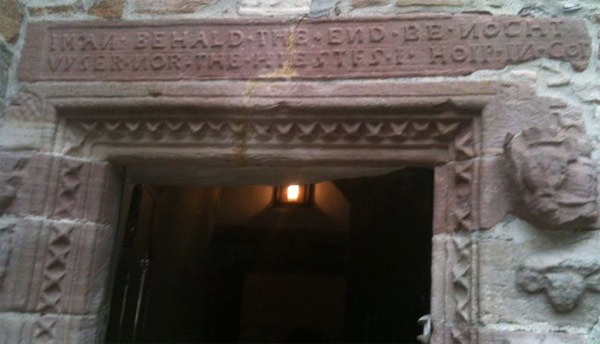
The weighty presence of the Earl of Argyll at Inveraray Castle, 15th Century L-plan powerhouse (the present castle was built in 1744), failed to deter Iain MacNaugtan or his descendants in their practices, political alliances or unfailing fidelity to the Stuart kings. Yet it was this fidelity that would be their death knell.
Like those before him, John, Lord of Dunderave, 16th Chief of Clan MacNaughtan, was a loyal Jacobite. His loyalties burrowed like a tick into the Campbell underbelly. With a vulture eye hooked on the prosperous MacNaughtan lands, Archibald Campbell, Ninth Earl of Argyll, brought suit against John, claiming lands in Glen Shira, including Beinn Bhuidhe House, belonged to the Campbells. The claim was involved and complicated, choking the courts from 1671-77 and eventually settling in Argyll’s favour.
The MacNaughtans had as much chance in the Argyll courts as a legless rabbit in a fox’s den. By “virtue of the reservation referred to in the Contract of 1628, Argyll was hereditary Justice-Genral of the Sheriffdom of Argyll and the Isles from 1628 until 1748,” according to John Cameron, editor of The Juristiciary Records of Argyll and the Isles (Vol. I). The Heritable Jurisdiction Act of 1747 finally ended this position, but from 1628 until then, the hereditary jurisdictions gave Argyll’s family a “dangerous authority in the Highlands and obstructed the course of public justice.”
Even if the Earl himself was not sitting at the bench, it was always a person he had appointed in his place as Justice-Depute or Justice-Substitute they were all Campbells.
Despite the overwhelming Campbell threat, John MacNaughtan and his men joined John Graham of Claverhouse in the 1689-90 rising known as Dundee’s Revolt. The nightmare failure of the revolt left the Campbell’s salivating at Dunderave’s door.
On January 1, 1692, clan chiefs were required to sign an oath of allegiance to King William. Broken and disheartened, John signed the oath. He was forced to bond out his property to cover the cost incurred by war, giving the Campbells opportunity to sink in their claws. Sir James Campbell of Ardkinglas now held the bond over the estates. John remained precariously at Dunderave.
In 1702 the MacNaughtan chieftainship fell on the shoulders of John MacNaughtan’s second son, also named John. He fell in love with the younger daughter of Ardkinglas, Margaret (A Campbell). Campbells and MacNaughtans had allied themselves in marriage in the past, yet John should have seen the shadows at the wall, even though the alliance could secure him Dunderave once again.
Sir James hosted the wedding at Ardkinglas, a fine estate across from Dunderave on the opposite shore of Loch Fyne. As legend goes, Campbell soaked John with enough alcohol to marry him to a rhinoceros without knowing the difference. In this debauched state he said his “I do” to the eldest daughter, Jane, and that night the bogus marriage was consummated. In the horror and shock of dawn, the hung-over MacNaughtan fled with Margaret, eventually to Ireland.
Meanwhile, in the sewn-up court of Aygyll where Ardkinglas had himself sat as Justice-Depute on occasion, Sir James obtained complete possession of the estates of John MacNaugtan on 24 August 1710, by securing a judgement and condemnation against him for the crime of incest. Under Scots Law and the Incest Act of 1567, the hime was punishable by hanging and the forfeiture of all the party’s estate and personal possessions.
Historical record reveals Jane gave birth to John MacNaughtan’s son who mysteriously drowned as a baby. Legend whispers that the “wee bain” was flung into the cold waters of Loch Fyne by Ardkinglas himself,” and Jane called down a curse on her sister, Margaret and the name MacNaughtan, so his line would end forever. Over the sea in Ireland John died without an heir in 1752.
No historical records can be found to substantiate the black tale of Campbell justice perpetrated against John MacNaughtan, except the bond against the estates. Yet the MacNaughtans simply vanished from Argyll at this point, and given the power of the Campbell court, records of this sort would not be expected to still exist. The Campbells were the record keepers.
Dunderave Castle from this time forward was in the net of Sir James Campbell of Ardkinglas. Eventually it was left to the owls and spiders, and by the 19th Century was a roof-less shell.
In 1911 Sir Andrew Noble commissioned Sir Robert Lorimer, an architect who loved the art and magic of historical buildings, to restore Dunderave. Lorimer kept the spirit and grace of the old castle intact, changing little of the structure when he built the additions. The original L-plan towerhouse remained the focus, with the additions low and quietly blending into the lines of the castle.
Gardens edged the court and fanned out from the castle. Dunderave, surrounded by lush emerald lawns at the edge of Loch Fyne’s silver waters, became a jewel of the Highlands.
The castle passed from Noble family to Lord Weir of Cathcart. His daughter-in-law occupied the castle until her death in 1988. Dunderave was then bought by Barry and Roma Weir who planned to turn it into a hotel.
Happily, they did not. In 1990 Dunderave was purchased by it’s present owner, a South African laser-surgeon pioneer. The castle retains all the flamboyance of its past, well-appointed for the ghost of a Scottish laird.
Although the staff speak quietly when they say there are no spirits at Dunderave, they are quick to point out the soft noises in unexpected places are nervously excused as the wind or “something like”.
Something … they whisper of the tale of a distraught young woman named Jane who flung herself to her death from a top-story window … or tell of that glimpse of a cloaked man walking up from the slip … or the soft cry of a wee bairn near the water’s edge.
.”Something” will always be waiting in the shadows of Dunderave. “Something” will always be there in the silences of the night. “Something” will always rise up at the name of Campbell, for the MacNaughtans are forever a part of the place, a part of the ancient light.
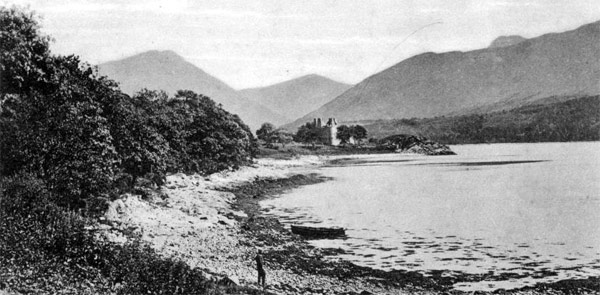

Thanks for the tale. As you said, there are many stories connected with Dunderave, and the McNaughton clan. This one is new to me, and I’ll share it with family.
John McNaughton fleeing with his true love to Ireland is perhaps a more romantic story than the reality, but his true fate is known and accounted for in historical records. He became a customs official in Anstruther in Fife before moving to Edinburgh where he continued to work as a collector of customs dues. I think he died in 1771 but I would have to check that date.
Great story well written. Have always been told of the Buchanan, McNaughton, “Sept of” clan affiliations with Weir which would seem to be associated with Weir-Cathcart finally taking possession of the Castle. However as descendant of Irish Weir am busily burrowing back in time to reach the Scottish shore and will be interested to then fill out the links and lineage for those that are gone before us. Currently have staked a firm date for first connection to Ireland via Isle of Mann c.1665 with a Weir burial at Duneane Co. Antrim for 1722. That is considered to be one generation from the clans of Scotland which bear the name. Would be interested in any links to websites for Weir which are relevant to this period of Scottish history. The Pentland rising, Covenanters and the many faceted face of Weir are grist for the myth mill and fable fabricator. But as I learned at the knee of my father it’s true that fact is more interesting than fiction. Looking forward to future posts. Thank you Amanda!! Leam.
Hi Leam,
My name is Reuben Connor and I am a descendant of the Weirs of Blackwood, Lanarkshire, Scotland.I don’t know if you will ever see this comment, but I thought I’d try anyway on the of chance. My 8th great grandfather, John Weir (1633-1697) came to Co. Antrim in 1664/5. His wife was Jane Adams (1644-1681).( She was off the same family as U.S Presidents John Adams and John Quincy Adams). John and Jane Weir settled at Straid, Ballymena, Co. Antrim in the Parish of Ahoghill. Straid is just two miles from my home. The area of Duneane is close to this area. I’m wondering if our Weir families could be connected. My line comes through John and Janes son Robert, as follows:
Robert Weir born 1666
David Weir 1702-1796
David Weir 1722-1797 Married Mary MacPherson, Born 1726. Both emmigrated to South Carolina, USA. David’s father may have too.
David Weir 1748-1837
Robert Weir 1770-1857 Married Martha Telford 1790-1872. Robert owned the Straid Corn Mills.
David Weir 1821-1890 Married Mary McDowell 1826-1899
Hugh Weir 1863-1948 Married Mary Ellen Nicholl 1864-1951
Euphemia Weir 1884-1922 Married Charles Connor 1879-1966
Matthew Connor 1922-1980 Married Margaret Glover 1929-1977
Reuben Connor
Here’s hoping to hear from you sometime.
Regards,
Reuben
STUNNING TALE. However Barry and Roma Weir spent millions restoring the castle to it present usable state. The Castle was then opened to a select few as a Boutique Hotel. First guests were Michael Winner….Jenny Seagrove…Roger Moore..Michael Cain… and other world stars. Only seven guest suites.
The castle was used in the film “BULLS EYE”. Barry and Roma were instantly accepted by the local community. Especially as their three daughters were to go to the local school.
The restoration and use as a Boutique Hotel brought world wide praise and put Dunderave Castle and Invererie on the world map!
Thanks Amanda For Sharing More Of Our Family History & Ancestral Home “Dunderave Castle”
My cousin, David Kellas, was pastor to Mrs. Weir in the early 60’s. When I came from Canada to visit him, I was invited to have tea with Mrs. Weir. Mrs. Weir and I not only had tea in her drawing room but she invited me to look around the castle. There are so many unique experiences I remember from my visit all those years ago. It has been one of the most memorable experiences in my life and my dream has been to return to Scotland to see the castle one day. If at all possible, I would really appreciate being able to get in touch with the current owner to see if this would be possible . My humble thank you! I have very much enjoyed reading your article, Amanda!
Hi Laura, I’m thinking my Uncle may have served your tea, or maybe my Aunt, as they were in service to Lady Weir in the early 1960’s. I stayed there for a few days with my parents and Lady Weir gave me a silver locket. Very kindly lady and I loved playing with her two dogs.
Oops, it was the early 70’s I was there.
Quite interesting!.My wife currently is employed as gardener at Dunderave Castle!
hope to visit and appreciate someday. much love from across the ocean in Canada!
In 1954, my father, mother, sister, grandparents, two aunts and I were graciously shown around Dunderave Castle by Lady Weir. I returned to visit in 1995 and again in 2001, but was not able to more than peer over the fence and shrubbery. Dunderave has been and is an integral part of this McNaughton’s heritage.
Related to John MacNaughton who changed his name to Norton. Supposedly was born at Dunderave castle in 1759-60. He was educated as a botinst and worked on the Yew Gardens in London. He married Eleanor Jones who was 16 when he met her he being in his 40s. They had nine children when they came to Prince Edward Island Canada. They later had two more.
It seems that John wanted to keep a low profile and changed his name before he came to The Island. He also had leather bound books in which he had torn out the fore pape that might have had his name on it.
Do not know who his father was does anyone have any idea?
Can one see the castle from the road or only from the water. My maternal grandmother was a MacNaughton from Ohio, USA
My maternal grandmother was also a McNaughton from Ohio. Her name was Faye.
I want to try and buy this back into ownership of the McNaughton clan one day.
Let’s do it!
I am a McNaughton (maiden name) and have tried to keep track of the ownership of Dunderave. We visited it when it was owned by the Weirs (a sept of McNaughton) and was proud of the fact that a McNaughton was back in the castle again. I know they put it up for sale. But I have never been able to find out if it sold and, if it did, who owns it now.
Here is what I can find online ………. Dunderave was then bought by Barry and Roma Weir who planned to turn it into a hotel. Happily, they did not. In 1990 Dunderave was purchased by it’s present owner, a South African laser-surgeon pioneer. The castle retains all the flamboyance of its past, well-appointed for the ghost of a Scottish laird.17 May 2017
In the shadows of Dunderave | ScotClans | Scottish Clans
https://www.scotclans.com/in-the-shadows-of-dunderave/
Have found this too – a picture of the current owners although report states he is an AMERICAN unlike the previous report that states he’s South African. Anyway, here it is ……….. http://alastaircunningham07.blogspot.com/2007/06/clan-macnaughton-and-dunderave-castle.html
He is an American from South Africa.
There’s some more information here about the castle on this website: http://www.dunderave-castle.co.uk.
This was commissioned by one former owner Barry Weir which gives a brief synopsis of some of its more recent history as well as a general overview.
Hello, My great grandfather was Charles McNaughton. My son and I are planning to visit Dunderave next April or May. I’m thinking we will set out from Glasgow. What suggestions do you have for a a visit to Dunderave and the area? Thank you.
My moms dad, Kenneth Mx naughtiness immigrated in later 1890s to Quebec, then into New York- Bronx area. My mom, born in Bronx, 1927. We found that we came from a castle owned by our descendants in 1600 century. Is this our Castle, or are castles scattered throughout the area?